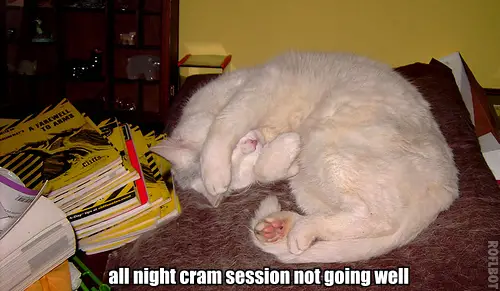All books used in this project were already damaged and headed to the trash.
People like to think that even the trashy romance from the 1960s that’s falling out of the binding and has first 6 pages are missing will still go to “good home” rather than being recycled as paper pulp. Old books all go off to the book retirement home and frolic in a meadow with the ghost of Beatrix Potter. There may be singing involved.
Booksellers know better. Most books don’t improve with age, anymore than clothing does. They get spots, holes, and go out of fashion. Nobody really wants that book on a fad diet from the 70s. Most books have only a limited period of desirability before no one wants them and are destined for recycling. Not every book is a winner.
But sometimes even the losers go on to a second act as art. People love books and love seeing them incorporated into other things. So books that are damaged but still have some charm might get to be turned into new treasures.
Rebound with new pages as a sketchbook:
From: Jaime Rose
If you handle used books, you often end up with people coming with piles of books from an estate. A relative has died and they’re left to try and clear out the house. Often, this is someone not from the area, so they’re clueless as to where to take things. Usually by the time they got to the books they’ve dealt with the common objects like housewares and clothing. Now its the things that they know (or think) have some value and aren’t sure what to do with. They don’t want to throw them out. They want them to go to a “good home” or to “someone who will appreciate them”. They’ll often use the same words when describing the books they just brought you. So since you handled the books they are inclined to ask YOU what to do with those OTHER items.
You won’t deal with these questions everyday, but its good to have the answers handy for just such situations. Remember, this is someone dealing with an estate. “Just throw it out” is not what they want to hear. This may well be what they do at the end, but they want other options.
First stop in many cases, especially if they just want items GONE should probably be either Craig’s List (if they want money for the item) or Freecycle (if they just want them GONE). If its things that are in poor condition and should be recycled, they can find the nearest recycling center through Earth 911.
The vast majority of 20th century books and pamphlets will be printed via offset press or as letterpress. What’s the difference? Offset transfer the ink to a rubber blanket before its put to a surface. It provides a more even print on less even papers. Letterpress directly applies the plate to paper which also produces a slight indent around the lines. It can make for slightly higher contrast in illustrations due to the faint indent.
Then there’s the tiny fraction of other things that were done using other duplication processes. Many items that were produced in very small batches for special events , local groups, etc were produced using various other methods that may require special handling. If you handle lots of ephemera, you may encounter alternate printing processes. Many fanzines, chapbooks, pamphlets, and APAs may use this methods. Also, if there’s no date on the item, but you CAN ID the process used, it will give you a better idea of the date and how many copies were probably produced.

Martin Luther King Jr.’s birthday has just passed and February is Black History Month in the US. Only a small fraction of books feature people of color, but to stroll through the aisles of a bookstore during the other 11 months of the year, it is easy to think there are none at all.
The publishing industry fuels this to some extent as there are all too frequent rows over bookcovers where the protagonist is depicted as white when they’re clearly described in the book as not-white. Now, some of this may the fault of the art department. Covers are often commissioned well in advance and the illustrator may not have been told the protagonist was not white, but that points to another flaw. It is automatically assumed the character MUST be white. You never have a brown face on the cover when the protagonist is white.
With a reprint of an established book you have all the time in the world to get it right. If you don’t, there are two likely reasons. Publishers assume people won’t buy a book with a brown face on it. Imagine for a moment, if a new edition of Harry Potter showed Harry without his glasses, because the wisdom was the people that don’t wear glasses will not buy a book with someone wearing glasses on the cover.
The other option is that the publisher does not think it MATTERS. If it is going to a reprint, clearly something about the characters resonated with buyers. They loved that character. Ignoring that trait denies that a character with brown skin CAN be loved.
“A Wizard of Earthsea” by Ursula Le Guin has been all over the place in depiction of the main character. For reference, he’s got reddish-brown skin. His best friend is black. The majority of the characters are brown, reddish-brown, or black. Whites are the minority.
1st edition (1968)- This is absolutely spot on and a very striking design. (Parnassus)

If you’re in the used book business you shelves pretty quickly end up groaning under the sheer number of volumes you have available. But sometimes the sheer volume can become an impediment to selling, especially with a physical store. If you’re online only, the only person that has to deal with the piles is you. In a store, if they piles get too large they can become difficult for customers to find what they want. Sales slow because there’s too much clutter and too many choices. There’s so many choices, people can’t decide what they want! and even if they did, they may be loathe to pull it out of the stack because they’re afraid it may fall!
So eventually, it comes times to prune down the piles. But you don’t want to go about pruning them willynilly. How do you pick what books to get rid of?
This becomes extra difficult if you listen to other booksellers. What works for them may not work for you, even if they’re in the same town! Great, their customers love this author…. you can’t give them away. (though trading it to them for something you need may work…) You need DATA. About YOU.
Memes are a relatively new idea that describes a very familiar concept. Memes are like cultural genes. They transmit cultural information and ideas through speech, gestures, and writing. Memes can also be contagious and sweep through a population, such as the earworm. Merely reading that the Macarena is an example of the contagious earworm is enough to have that damn music start running through your head. You may not remember all the words, or the dance, but, oh, you remember the general tune and madness that went with the Macarena.
It’s cousin is the internet meme, those silly things that sweep the internet sporadically. Internet memes are notoroious for mating with other memes and mutating into new forms. Memes combine and mutate offline as well, but mass medias spreads them faster and the interent sends the rate of transmission to warp speed. The internet meme probably most familiar to even inexperienced internet users is the LOLcat.

Internet memes appear to spontaneously appear out of nowhere, but even the Lolcat has a pedigree tied into original print media and constantly refers back to older memes. The idea of a picture of a cat with an amusing caption is hardly new. You can find whole books of them as soon as printing photos became economically feasible.
As soon as the photocopier became available, this type of picture was widely circulated through offices. Sometimes it appeared via fax machine. Virtually every break room had the many times photocopied picture of a cat hanging off a limb with some variation of “just hanging in there” as a caption through much of the 80s and 90s. The photocopier allowed some basic mutation of photos and text as you could cut and paste an image and text together, but you still had to GET the picture and use a fairly expensive (if relatively common) piece of office equipment to distribute it.
Of course publishers continued to churn those out these images on greeting cards, calenders, magazines, and books, but they were a lot more home made ones out there as well.
The internet just allowed them to be circulated more quickly and by a greater variety of people. Digital cameras also allowed people to quickly generate the necessary photos. The production cost fell through the floor and there were no gatekeepers to tell people NOT to do things. There are even websites that will do all the hard editing work. Just link to or upload a picture and type in the text! (such as ROFLBot, which was used in the photo above)
The internet version mutated and merged with the longstanding literary tradition that animals are terrible typists (see The Silent Meow by Paul Gallico or The Bunnicula series by James Howe) and spawned the LOLcat we all know and love. The LOL part refers to early internetism of LOL, which was short for Laughing Out Loud. It was just faster to type and is now widely used in text messages. But you still need to know what the abbreviation itself stands for to even understand the name of the meme itself.
Everyone has difficult customers. Everyone has bad days where the next customer that asks for “that book, the new one, I think’s it’s red” is going to make you scream. Everyone has transactions that are just one problem after another.
This is not about those customers. Nor is it about the looky-loos that never buy anything. They aren’t customers at all.
 This is about people who you’re better off not taking their money at all. In down times it’s often tempting to hang onto anyone that gives you money… but these customers are such trouble that they end up COSTING you more than you make from them. You’re afraid to say anything about their bad behavior because of the fear of losing them. They chew up time that you could be spending on other more productive parts of your business, they scare other customers, or they make your staff quit so you have to train new ones. So if you call them on the bad behavior and they leave, it’s actually a win for you!
This is about people who you’re better off not taking their money at all. In down times it’s often tempting to hang onto anyone that gives you money… but these customers are such trouble that they end up COSTING you more than you make from them. You’re afraid to say anything about their bad behavior because of the fear of losing them. They chew up time that you could be spending on other more productive parts of your business, they scare other customers, or they make your staff quit so you have to train new ones. So if you call them on the bad behavior and they leave, it’s actually a win for you!
How can you tell if a customer should be fired, rather than that are just difficult?
Keep in mind, this is a PATTERN, not a single day. You can have bad days with good customers. You can have difficult customers that are worth the time and effort to satisfy them. There are GOOD DAYS with that customer. It’s not overwhelmingly bad. The key with bad customers is that they are such a drain on you that they take more than they give back in business.
Sometimes simply telling people you aren’t putting up with this behavior may mean they change it and will stick around anyway… but be easier to deal with. They may just need a firm “no” to get them to stop the behavior that’s making them such a drain. Sometimes it means they take their business elsewhere. But for truly odious individuals, they may have already exhausted other businesses that will put up with this behavior. You may be the last remaining sucker that puts up with them.
Do you recognize these people?